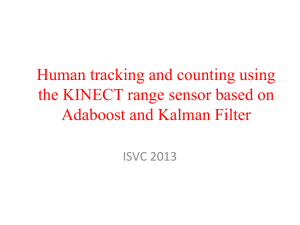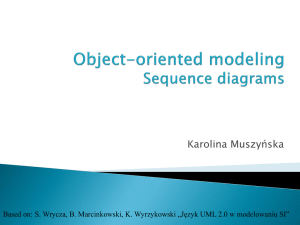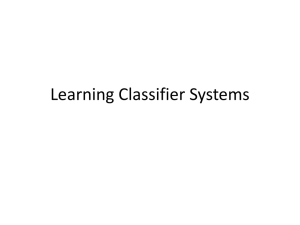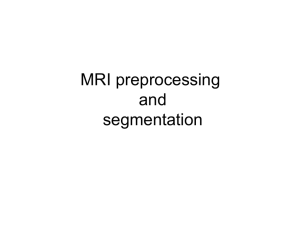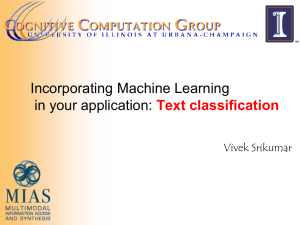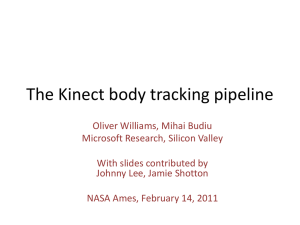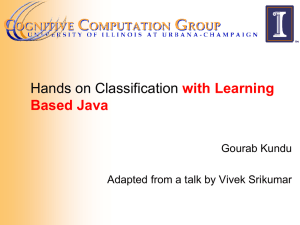Presentation - Center for STEM Education
advertisement
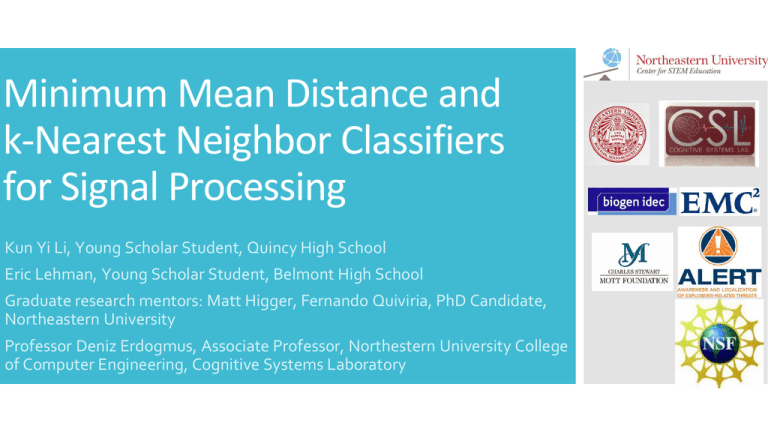
Minimum Mean Distance and k-Nearest Neighbor Classifiers for Signal Processing Kun Yi Li, Young Scholar Student, Quincy High School Eric Lehman, Young Scholar Student, Belmont High School Graduate research mentors: Matt Higger, Fernando Quiviria, PhD Candidate, Northeastern University Professor Deniz Erdogmus, Associate Professor, Northestern University College of Computer Engineering, Cognitive Systems Laboratory Why use brain interfaces? Image Source: http://i2.cdn.turner.com/cnn/dam/assets/ 121016060125-orig-ideas-brainwavewheelchair-00013909-story-top.jpg Stimulus EEG User Brain Interface Classifier Decision SSVEP Brain Interface Video •SSVEP: Stands for “Steady State Visually Evoked Potential”. Definitions This type of brain signal is a response to looking at repeated intensities of light from 0 to 60 Hz. •EEG: Stands for “electroencephalography”. EEG data is the measurement of the brain’s electrical activity voltages on the surface of the scalp over a certain period of time. •Iris Dataset: A dataset that contains 3 different types for flowers, 50 samples each, and 4 different features (sepal length in cm, sepal width in cm, petal length in cm, petal width in cm). •Classifier: An algorithm that divides data into different group based on their similarities. • An algorithm that classifies multiple types of data. • When given a test point, the program: 1. calculates the distance from the new data point to the average of training data points. Minimum Mean Distance Classifier 2. selects the training data point with the shortest distance 3. identifies the new data point in the same group as the closest training point. 6 Classification of Iris Flower Dataset Using Minimum Mean Distance Classifier Ground Truth Class Minimum Mean Distance Classifier I. setosa Estimated Class I. versicolor I. virginica I. setosa I. versicolor I. virginica 1 0 0 0 0.92 0.14 0 0.08 0.86 7 Classification of EEG Data Using Minimum Mean Distance Classifier Ground Truth Class Minimum Mean Distance Classifier Estimated Class 20 Hz 15 Hz 12 Hz 20 Hz 1 0 0 15 Hz 0 1 0 12 Hz 0 0 1 8 • An algorithm that classifies and divides multiple types of data. • When given a new test data point, the KNN classifier: • 1. Calculates the distance from the test data to all training data points k-Nearest Neighbor Classifier • 2. Selects the k number of training data points that are the closest to the test data point • 3. Identifies the test data point as the same as the most common class among the k nearest training data points 9 Classification of Iris Flower Dataset Using Minimum Mean Distance Classifier Ground Truth Class k-Nearest Neighbor Classifier I. setosa Estimated Class I. versicolor I. virginica I. setosa I. versicolor I. virginica 1 0 0 0 0.94 0.04 0 0.06 0.96 10 Classification of EEG Data Using K-Nearest Neighbor Classifier Ground Truth Class K-Nearest Neighbor Classifier Estimated Class 20 Hz 15 Hz 12 Hz 20 Hz 1 0 0 15 Hz 0 1 0 12 Hz 0 0 1 11 • Separates the training set from the test set by segmenting the data into k number of sections • The classifier will test on one section and train the remaining sections K Fold Cross Validation • Prevents overfitting Image Source: http://classes.engr.oregonstate.edu/eecs/winter2011/cs434/notes/knn-4.pdf 12 • RSVP Typing system • Uses P300 brain signal to determine which letter is the acquired target Applications • SSVEP brain interface • Control robot motions through looking at a screen Image Source: http://www3.ece.neu.edu/~purwar/research/photo_gallery.htm, http://www3.ece.neu.edu/~orhan/ Can classify not just EEG data, but many other types of data! Iris Flower Dataset Applications Image source: http://en.wikipedia.org/wiki/Iris_flower_data_set 14 • Perform K-Fold Cross Validation • Classify unprocessed EEG data using more advanced concepts to determine the most likely decision Future Work • Classify EEG data obtained from other types of stimuli such as tactile sensors • Help individuals with Locked-in Syndrome to communicate and with others through brain interfaces •Graduate Research Mentors: Matt Higger, Fernando Quivira, PhD Candidates, Northeastern University •Professor Deniz Erdogmus, Department of Electrical and Acknowledgements Computer Engineering, Cognitive Systems Lab, Northeastern University •Orkan Sezer, Summer intern, Northeastern University •Center for STEM Education •Young Scholars Program & Team •Claire Duggan - Director •Kassi Stein, Jake Holstein, Chi Tse - YSP Coordinators Questions?

